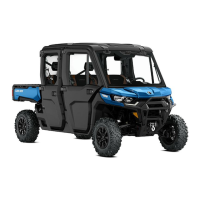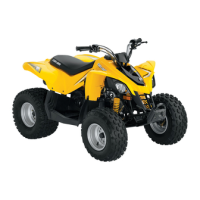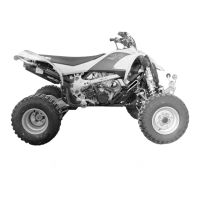SAFE O PE RATIO N - RESPON S IBILITIES
Carrying Passengers
Only carry a m a ximum of five passen-
gers. The passeng ers mus t be prop-
erly seated in the cockpit.
The pass engers mus t be tall enough
to always be properly seated: back
against the backrest with seat belt fas-
tened, holding the handhold, and f eet
firmly planted - for the front RH pas-
senger, with right foot on the footrest
and the left foot on the vehicle floor,
for the central pa ssen ger and the three
rear passen gers , w ith both feet firmly
planted on the floor.
Never carry pa ssen gers who have
used drugs or alcohol, or are tired or
ill. These slow reaction time and im-
pair judgm ent.
Instruct the passengers to read the ve-
hicle’s safety label s .
Never c arry passengers if you judge
their ability or judgement insufficient
to con centrate on th e terrain condi-
tions and adapt accordin gly. More
specifically for side-by -si de v ehicles,
the pa s s enger must also pay c ons ta nt
attention to the terrain ahead and be
able to brace for bum ps.
Ridi ng Carefully
– This vehicle handles differently
from other vehicles. A c ollision or
rollover ca n occu r quickly, during
abrupt maneuvers suc h as doi ng
sharp t urns , acceleration or dec el-
eration and driving on hills or over
obstacles, i f you fail to take proper
precautions.
– Nev er operate at excessive speeds.
Always go at a speed that is proper
for the terrain, visibility, and operat-
ing conditions, and your experience.
– Nev er atte m pt jumps, side slides,
donuts or a ny other stunts.
– Never attempt rapi d accelerati on
or deceleration when performing a
sharp t urn. This m a y result in a roll
over.
– Nev er attempt skid ding or sli ding.
If vehicle starts to skid or slide,
counter st eer in the direction of
skidding or sliding. On extremely
slipp ery surfaces, su ch as ice, go
slowly and be v ery cautious in order
to reduce the c ha nc e o f skidding out
of control.
– A lw ays be s ure there are no o bs ta-
cles or people behind the vehicle
when y ou operate in reverse. Pay
attention to blind spots. When it
is safe to proceed in reverse, go
slowly.
– Nev er exceed the stated load lim-
its for this vehicle. C a rgo must be
properly secured. Reduce speed,
allow for greater braking distance
and foll ow other instructions in
MOVING LOADS AND DOING
WORK
.
– A lw ays r em ember that this vehicle
is h ea vy! I t s pu re weight a lone ma y
entrap you s hould it tip or rollover.
Occupa nt Restrai nt
System
– This v ehicle is designed to ca rry o ne
driver an d up to five passe ngers, all
wearing proper protec tive gears (re-
fer to
RIDING GEAR
in this section).
– The driver and passengers must
latch the doors or the side nets a nd
wear the seat belts at all times when
riding.
Terrain Condition
– This v ehicle is not designed to ride
on paved surfaces; if you m ust
shortly use the vehicle on s uc h sur-
faces, avoid a brupt inputs to steer-
ing wheel, accelerator and brake
pedals.
– A lways go s lowly a nd be ex tra care-
ful when operating on unfamiliar
terrain. Alw a y s be ale rt to changing
terrain conditions when operating
this vehicle. Ta ke the time to learn
how the vehicle performs in differ-
ent environments.
12
_______
SAFETY IN FORM ATION
________

